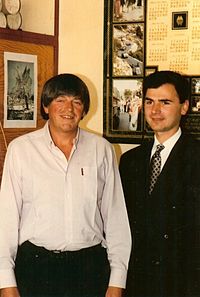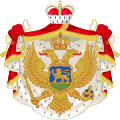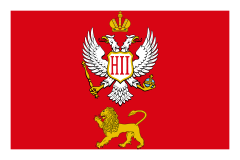- Crown Prince Nicholas II of Montenegro
-
Nikola II Petrović-Njegoš Crown Prince of Montenegro Head of the Royal House of Montenegro Period 24 March 1986 - present Predecessor King Mihajlo I Heir apparent Hereditary Prince Boris Consort Francine Navarro Issue Princess Altinaï of Montenegro
Boris, Hereditary Prince of MontenegroFull name Nikola Mihajlo Frane House House of Petrović-Njegoš Father titular King Mihajlo I Mother Geneviève Prigent Born 7 July 1944
Saint-Nicolas-du-Pélem, FranceSignature 
Montenegrin Royal Family - HRH The Crown Prince
- HRH The Grand Duke of Grahovo and Zeta
HRH The Grand Duchess of Grahovo and Zeta- HH Princess Miléna
- HRH Princess Altinaï
- HRH The Grand Duke of Grahovo and Zeta
Reference style His Royal Highness Spoken style Your Royal Highness Alternative style Sir Nikola II Petrović-Njegoš, Crown Prince of Montenegro (Cyrillic: Никола Петровић-Његош; Montenegrin: Nikola Petrović-Njegoš) (born 7 July 1944 in Saint-Nicolas-du-Pélem) is the Head of the House of Petrović-Njegoš which once reigned over Montenegro. He is Hereditary Grand Master of the Dynastic Orders of Petrović-Njegoš, St. Peter of Cetinje and Prince Danilo I of Montenegro.
In 2011 Montenegro recognized an official role for the former Royal house of House of Petrović-Njegoš in Montenegro: to promote Montenegrin identity, culture and traditions through cultural, humanitarian and other non-political activities.[1]
Contents
New status of the Petrović Njegoš dynasty
On the 12 July 2011 the Parliament of Montenegro adopted the Law on the Status of the Descendants of the Petrović Njegoš Dynasty. [2][3]
The law "regulates the important issues regarding the status of the descendants of the Petrović-Njegoš dynasty, for the historical and moral rehabilitation of the Petrović-Njegoš dynasty for whom their dethroning was contrary to the Constitution of the Kingdom of Montenegro, a violent act of annexation in the year 1918." (Article 1).
The law recognises the descendants of King Nikola I in the male line and their wives as the descendants of the Petrović-Njegoš dynasty (Article 2), and appoints the eldest male heir, namely Prince Nikola II, as the representative of the dynasty (Article 5). It also affirms the House law of the dynasty by defining the succession to the headship of the dynasty as being passed down through the "male heir of the oldest male heir" (Article 5).
The law protects the use of the heraldic symbols of the dynasty by the representative of the dynasty, Prince Nikola II (Article 6).
Article 8 allows for members of the dynasty to obtain Montenegrin citizenship and also to be dual-nationals of other nations without losing their Montenegrin citizenship. This is of particular relevance today as all of the members of the dynasty currently also hold French citizenship.
The law also creates the non-political (Article 10) Petrović-Njegoš Foundation (Article 9), an organisation chaired by Prince Nikola II (Article 10), with its aim to "affirm the Montenegrin culture and participation in humanitarian and development activities in the interest of Montenegro and its traditions" (Article 9).
From Montenegro's exchequer, the law allocates 4.3 million euros over a seven year period to the Petrović-Njegoš Foundation (Article 11). In addition, Prince Nikola II is entitled to a monthly income equivalent to the gross monthly earnings of the President of Montenegro (Article 16).
The Petrovic-Njegoš Foundation has its seat in Montenegro. "The Descendants of the dynasty are given the continuous use of the house of King Nikola I Petrović-Njegoš in Njeguši...its gardens...and meadow-land."
"Descendants of the dynasty will have built for them a family home in Cetinje...and be given an apartment in Podgorica" (Article 12).
To carry out their official functions Prince Nikola II has the right to use State objects and resources and "the exclusive right of use of the first storey" of the Petrović Palace (Dvorac Petrovića) in Podgorica, "and when protocol requires, use of the ground floor with priority over other users" (Article 13).
The law allows for Prince Nikola II to act as a representative of the Government of Montenegro and perform other protocolar and non-political functions (Article 7). The first such undertaking was made by the Prince in July 2011 when he represented the Prime Minister of Montenegro, Igor Lukšić, at the requiem of Otto von Habsburg, former Crown Prince of Austria-Hungary.
When performing functions on behalf of the Government, Prince Nikola II and the other members of the dynasty are afforded full State protocol (Article 15).
Family background
The house of Petrović came originally from Herzegovina and settled in Njeguši around 1400. Niegosch was born around 1425 and became the Voivode of Njegoš.
Prince Nikola II descends from Danilo Petrović-Njegoš who obtained the hereditary Dignity of Vladika (Prince-Bishop) of Montenegro in 1711 when it became a theocracy. Danilo I Petrović-Njegoš was recognized as Sovereign Prince of Montenegro by Russia on 21 March 1852, and established succession by male primogeniture. His successor, Prince Nikola I assumed the style of Royal Highness on 19 December 1900, and the title of King 28 August 1910.
Nikola is also related to the former royal House of Obrenović through Yephrem, younger full brother of Miloš Obrenović I, Prince of Serbia.
During World War I the Petrović Njegoš family were forced to flee the country in 1915 after the Army of Montenegro was overwhelmed by the troops of the Austro-Hungarian Empire. At the end of the war, the Kingdom of Serbia annexed Montenegro while abolishing the Kingdom of Montenegro and deposing the Petrović Njegoš dynasty.
The family made their home in France where Nikola I of Montenegro died in exile in 1921. The same year, King Nikola's maternal grandson, Alexandar Karađorđević (Prince Nikola I's cousin) became king of the Kingdom of Serbs, Croats and Slovenes, of which Montenegro had become a part. Though the Kingdom of the Serbs, Croats and Slovenes was proclaimed on 13 November 1918, it was never recognized by Nikola I, who maintained a government-in-exile, which was headed by the ex-king's former aide-de-camp and ambassador to Washington, General Anto Gvozdenović, until the Conference of Ambassadors at Paris gave international recognition to the union 13 July 1922.
Nikola I's heir at death was his eldest son, Prince Danilo (titular King Danilo II), who "abdicated" after one week, and the family's dynastic claim was taken up by his grandson, Michael, Prince of Montenegro, the titular King Mihajlo I, who was the father of Prince Nikola II and died in exile in 1986.
Though Prince Nikola II is de jure King of Montenegro he currently uses the style of "His Royal Highness Crown Prince" or "His Royal Highness Prince Nikola II of Montenegro."[citation needed]
Biography
 Prince Nikola with Dejan Stojanovic
Prince Nikola with Dejan Stojanovic
Prince Nikola II is the only son and heir of the late Prince Michael of Montenegro, Grand-Duke of Grahovo and Zeta, who lived in exile under a "regency" (born on 1 September O.S., 1908 and regarded by Montenegro's monarchists as king from 7 March 1921 until his death in 1986, and Geneviève Prigent (1919-1991). (Nikola's parents married on 27 January 1941 and divorced in Paris, France on 11 August 1949).
Nikola was an active participant in the campaign for the restoration of Montenegro's independence, preceding the referendum on the separation of the former kingdom from the provisional State Union of Serbia and Montenegro.
Prince Nikola made public pronouncements of his willingness to return to the Montenegrin throne if that were the wish of the people. In July 2010 the government of Montenegro made a formal offer to provide Nikola with a €3,000 monthly stipend (equal to that of the President), granting his family with an annual €300,000 civil list, a formal residence in Cetinje and the return of the Petrović Njegoš historic family home in Njeguši. This offer was rejected because Nikola believed that the proposal did not deal adequately with the issue of property compensation, as more than thirty properties were alleged to have been confiscated from the dynasty after the monarchy was overthrown.[citation needed] Furthermore, he believed that the bill would prevent the dynasty from participating in political life and restrict the ability of members of the dynasty to speak freely about certain subjects. He also said that the civil list amount that was announced in the press was not actually contained in the proposed version of the bill that he was shown.
Owing to his stance on this bill, Nikola chose not to attend the celebrations of the centenary of the Kingdom of Montenegro that were held on 28 August 2010.[4] Instead he celebrated in private.
Education
Nikola was educated in France. In 1964 he was admitted to the Ecole Nationale Supérieure des Beaux-Arts in Paris, and between 1965 and 1967 he attended training courses in several architectural practices. Between 1967 and 1971 he worked on several architectural projects, including a winter sports resort in Avoriaz, France, and with Shamaï Haber on several university science faculties.
In 1971, he was awarded a diploma in Architecture and admitted to the Société Française des Architectes. Nikola has stated that he wishes to construct the first eco-built residence in Montenegro when designing his family's new home in Cetinje.
Marriage and children
In 1976 he married Francine Navarro in Trebeurden, Côtes-du-Nord on 27 November. She died in Paris on 6 August 2008. Together they raised a family at Les Lilas, France;
- Princess Altinaï Petrović-Njegoš of Montenegro, born at Les Lilas, Seine-Saint-Denis on 27 October 1977.
- Prince Boris Petrović-Njegoš of Montenegro, Grand-Duke (Voivode) of Grahovo and Zeta, born at Les Lilas on 21 January 1980.
Decorations and honours
Montenegrin Decorations:
- Grand Master and Grand Cross of the Order of Order of Petrović Njegoš (OPN)
- Grand Master and Grand Cross of the Order of Saint Peter of Cetinje (OStP)
- Grand Master and Knight Grand Cross with Diamond Star and Collar of the Order of Prince Danilo I of Montenegro (GCDO)
Foreign Decorations:
- Bailiff Grand Cross of Honour and Devotion of the Sovereign Military Hospitaller Order of St. John of Jerusalem of Rhodes and of Malta [5]
- Italian Red Cross Gold Medal [6]
- Supreme Order of the Holy Annunciation [7]
- Grand Cross Order of Saints Maurice and Lazarus, Savoy
- Grand Cross Order of Our Lady of the Conception of Vila Viçosa, Portugal
- Grand Cross of the Royal Order of Francis I, Two Sicilies [8]
- Golden Medal of Honour of the Sacred Military Constantinian Order of Saint George, Two Sicilies.
- Grand Cross Order of the Dragon of Annam [9]
- Grand Collar Order of the Eagle of Georgia and the Tunic of Our Lord Jesus Christ [10]
Foreign Honours:
- Honorary citizen of Agrigento, Sicily, Italy (June 23, 2007) [11]
Coat of arms
He bears the Montenegrin Coat of Arms, which can be seen at the centre of the Flag of Montenegro. The Royal Coat of Arms is borne by the head of the Petrović Njegoš Dynasty, and differs from the family Coat of Arms.[12]
The Constitution of 2007 maintained "the tradition" of King Nikola I: the adopted Coat of Arms was a crowned silver eagle with the sara in one and the scepter in the other claw, and charged on its breast was a red shield with the lion passant.
The 2011 Law on the Status of the Descendants of the Petrović Njegoš Dynasty[13] states that Prince Nikola II "may use the heraldic symbols of the Petrović Njegoš dynasty" (Article 6).
Royal Standard
In Petrović Njegoš’s standard there is a red background bordered by white, with the double-headed eagle and the initials in Cyrillic N. I. I. (Nikola II) on its breast, with the lion passant underneath.[citation needed] This standard is flown over the Prince’s palace at Cetinje. It is also used as a distinguishing insignia on vehicles, ships, aircraft and in the Military. The other version is a tricolor with initials NII and a crown on top.
Radio-interviews and documentary films
- The Njegoskij Fund Network: "A Prince in Paris", radio-interview by Sonia Zoran for the Radio Suisse Romande (RSR) - La Première (Switzerland, May 27, 2007).
- The Njegoskij Fund Network: "The Independence of Montenegro", radio-interview by Pierre Maisonneuve for Radio-Canada - Première Chaîne (Montréal, Québec, Canada, May 22, 2006).
- The Njegoskij Fund Network: "The man who did not want to be king", documentary film by Anne Georget for France 3 TV channel (France, September 16, 1995).
- The Njegoskij Fund Network: "The 1991’s appeal of Prince Nicolas Petrovitch Njegosh" on Radio France Internationale (RFI) (France, 1991).
References
- ^ Zakon o statusu potomaka dinastije Petrović Njegoš
- ^ Zakon o statusu potomaka dinastije Petrović Njegoš
- ^ PM Luksic hosts reception in honour of Montenegrin Royal House of Petrovic Njegos
- ^ Les Courrier des Balkan, Montenegro celebrates 100 years of the kingdom without an heir of the dynasty Petrovic Njegos. August 30 2010
- ^ "The Crown Prince was invested with the Bailiff Grand Cross of the Order of Malta"
- ^ "His Royal Highness was invested with the Grand Cross of the Italian Red Cross"
- ^ Supreme Order of the Holy Annunciation
- ^ The Crown Prince was invested with the Grand Cross of the Royal Order of Francis I
- ^ Njegoskij|org :: "Exchange of protocols between the Royal House of Montenegro and the Imperial House of Vietnam"
- ^ Njegoskij|org :: "Exchange of protocols between the Royal House of Montenegro and the IRoyal House of Georgia"
- ^ Crown Prince was created an Honorary Citizen of the City of Agrigento
- ^ Héraldique Européenne
- ^ Zakon o statusu potomaka dinastije Petrović Njegoš
External links
- The Order of Prince Danilo I Official website of the Royal House of Montenegro and dynastic Orders.
- Njegoskij|org :: The Royal House of Montenegro | News and media.
- Flags of the World Flags of the World.
Crown Prince Nicholas II of MontenegroBorn: 7 July 1944Regnal titles Vacant Title last held byMihajlo I— TITULAR —
King of Montenegro
1986 – presentIncumbent
Heir:
Prince BorisCategories:- 1944 births
- Living people
- People from Côtes-d'Armor
- Heirs apparent who never acceded
- History of Montenegro
- House of Petrovic-Njegoš
- Montenegrin nobility
- Pretenders to the Montenegrin throne
- Princes of Montenegro
- Knights Grand Cross of the Order of Prince Danilo I of Montenegro
- Knights Grand Cross of the Royal Order of Francis I
Wikimedia Foundation. 2010.
Look at other dictionaries:
Nicholas I of Montenegro — Nicholas I King Nikola (Nicholas) I Prince of Montenegro Reign 13 August 1860 28 August 1910 Predecessor … Wikipedia
Danilo, Crown Prince of Montenegro — Danilo Crown Prince of Montenegro Pretendence 1 March 1921 – 7 March 1921 Predecessor King Nicholas Successor Prince … Wikipedia
Alexander, Crown Prince of Yugoslavia — Alexander Александар Crown Prince of Yugoslavia The Crown Prince at the celebrations of the wedding of Victoria, Crown Princess of Sweden, and Daniel Westling, 18 June 2010 … Wikipedia
George, Crown Prince of Serbia — George Crown Prince of Serbia Official portrait House House of Karađorđević Father Peter I … Wikipedia
Montenegro — This article is about the country in Europe. For other uses, see Montenegro (disambiguation) and Crna Gora (disambiguation). Montenegro Црна Гора Crna Gora … Wikipedia
Prince Mirko of Montenegro — Prince Mirko Grand Voivode of Grahovo and Zetà Spouse Natalija Konstantinovic Issue Prince Stephan Prince Stanislaw Michael, Prince of Mon … Wikipedia
Nicholas II of Russia — Nicholas II redirects here. For other uses, see Nicholas II (disambiguation). Nicholas II Emperor and Autocrat of All the Russias Reign 1 Novem … Wikipedia
Prince Dimitri of Yugoslavia (b. 1958) — Prince Dimitri Father Prince Alexander of Yugoslavia Mother Princess Maria Pia of Savoy Born 18 June 1958 (1958 06 18) (age 53) Boulogne sur Seine, France … Wikipedia
Prince Michael of Yugoslavia (b. 1958) — Prince Michael Prince Michael of Yugoslavia Full name Michael Nicolas Paul George Maria House House of Karađorđević Father Prince Alexander of Yugoslavia Mother Princess Maria Pia of Savoy Born 18 June 1 … Wikipedia
Prince Andrew of Yugoslavia — Prince Andrew Prince of Yugoslavia Spouse Princess Christina Margarethe of Hesse (m. 1956 div. 1962) Princess Kira of Leiningen (m. 1963 div. 1972) Eva Maria Andjelkovich (m. 1974 his death) Issue Princess Maria Tatiana Prince Christopher… … Wikipedia
- HRH The Crown Prince


